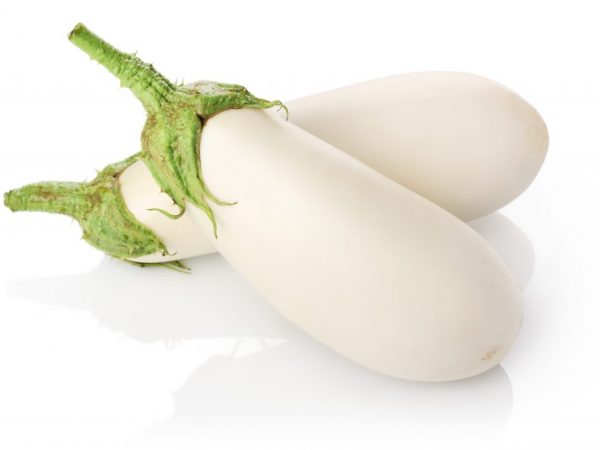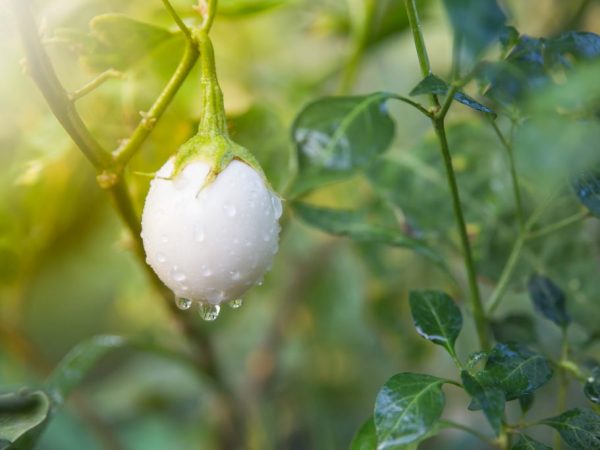Description of Bibo eggplant
Bibo's eggplant is a newly developed high-yielding variety. Its difference is its unusual color and pleasant taste. The variety has good immunity to diseases and pests.

Description of Bibo eggplant
Characteristics of the variety
The Bibo variety is a hybrid of white eggplant. Variety Bibo f1 - early maturing. The crop is harvested within 90-95 days after germination of seedlings.
Cultivation is possible both in the open field and in the protected. It also has a good yield indicator - 4.8kg / m2. This species grows well in all weather conditions. Resistant to fusarium and tobacco mosaic virus. The disadvantage is the inability to independently collect the seeds and retain all the characteristics of the hybrid.
Description of the bush
The plant is undersized or medium-sized - up to 85 cm. Stems are poorly set, lilac in color. The leaves are small, green, and have a slightly wavy edge. Fruit cups with frequent thorns. The fruits of this variety do not contain solanine, therefore they have a more delicate taste than other types.
Description of fruits
Eggplants are oval in shape, with a glossy white skin. Fruits are small, weight is 190-210g, sometimes 400g. The pulp without bitterness with a pleasant taste.
Fruits contain a lot of phosphorus, potassium, iron and other useful elements. It is advisable to harvest them when they are not fully ripe and cook them on the grill or in the oven. They are also baked breaded with tomatoes and herbs.
Growing varieties
Planting seeds
First you need to prepare the seeds for sowing. If there is a mark on the package that they are processed, then you do not need to do anything. If there is no such information, check for weightiness. Seeds are poured with water and those that have surfaced are discarded.
After the seeds are rubbed with a solution of potassium permanganate. Since this variety has good germination, additional processing is not necessary.
To make the seedlings grow better, take separate containers (volume 400-450 ml). For the Bibo variety, picking is not desirable, and when planting in individual cups, it is not necessary.
It is better to take loose and nutritious soil. A mixture of black soil and peat with sand is well suited. Or soil with vermicompost. Seeds are sown at a depth of 1-2 cm.When sowing in a box, maintain an interval of 5 cm.
Sprout care
The first shoots appear in 1.5 weeks. But if the temperature is below 15 ° C, the seedlings may not germinate, so it is important to maintain it at a level of 20-25 ° C.
In order for the seedlings to be strong, you should properly care for them:
- water only with warm water;
- after the appearance of the first shoots, transfer the seedlings to a warm, bright place;
- fertilize after the first leaves appear;
- start hardening before planting.
Transplanting

It is important to properly care for plants.
The best time for planting seedlings in open ground is late April or early May. The plant should have 4-5 true leaves. For planting, choose beds located on a hill with a high content of mineral fertilizers. But the variety grows well on land with an acidity of 6.3-6.7 pH.
The garden has been prepared since autumn. It is fertilized with organic matter (compost or manure). Use 1 bucket of top dressing per 1 m². It is not advisable to plant seedlings in one place for several years. They do not grow well in the area where nightshades used to be. The best predecessor is greens, carrots, melons.
For Bibo f1 eggplants, space is important. If you plant them too thickly, the yield will be low. The row spacing should be at least 60 cm, the distance between plants should be 30 cm.
Description of landing rules:
- One cup of warm water is poured into a hole 10-15 cm deep. You can take mullein solution.
- It is better to plant seedlings in cloudy weather. Or cover the plants from the sun for the first 2-3 days.
- When planting in a greenhouse, take more adult seedlings. There should be at least 5-6 sheets.
- During the day, a temperature of 26-27 ° C is required, at night - 20-23 ° C.
Fertilizer
Eggplant Bibo f1 is susceptible to feeding and gives a good harvest. Growing in a greenhouse requires more feeding. During the season, the vegetable is fertilized 3-4 times:
- The first fertilizer is applied 2 weeks after planting. Use a solution of Nitrofoski (50 g / 5 L of water, 1 L per bush).
- The second feeding is carried out before the beginning of the flowering period. Better to use Kemira or Kristalon.
- Fertilizer is applied when the plant begins to form ovaries and after collecting the first fruits and repeat after 2 weeks. Phosphorus or potash fertilizers are used.
Watering
These plants love water, so the soil should always be moist. The beds are watered 2 times a week. It is important to avoid the appearance of a soil crust.
The dense leaves can withstand high temperatures if you mulch the soil around the plant after watering the garden. So the soil will retain moisture and the weeds will not interfere with the growth of the eggplant. Use humus, straw or peat.
Diseases and pests
Bibo eggplants are disease resistant with proper care. Sometimes they are attacked by Colorado beetles. These insects are collected by hand in the morning or evening and destroyed.
Spider mites and aphids sometimes interfere with getting a good harvest. Sometimes the stems are affected by late blight and black leg.
Fight disease
The black leg of the Bibo eggplant appears due to excess moisture. The trunk begins to darken and the plant dies. To prevent disease, the watering regime is observed and the soil moisture level is monitored.
Late blight is a fungal disease. Excess moisture also contributes to its appearance. In sunny weather and dry air, it does not appear. Late blight is treated with Bordeaux mixture, copper sulfate solution, or Antracol and Contento preparations. After processing, the fruits are eaten only after 10 days.
Pest control
Insecticides will help in the fight against pests. It is better to choose drugs that quickly decompose in the ground. This will reduce the damage to the soil.
The slugs that appear are removed by hand. Then a mixture of lime, ash and tobacco dust is sprayed between the beds with Bibo eggplants.
Prophylaxis
It is useful to plant basil, calendula or marigolds in beds with eggplants. Their smell repels pests well. Also, for prevention, plants are planted in plastic bottles. Pests will not be able to climb smooth surfaces and ruin crops.
Conclusion
Growing a Bibo F1 eggplant is not difficult. They are not picky about care, they can tolerate temperature extremes, and they effectively resist diseases.
Bibo eggplants are well suited for growing by beginner gardeners. It is only important to follow the rules for caring for plants.


